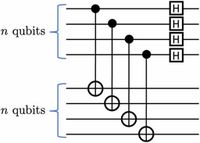In a groundbreaking development within quantum computing, researchers have introduced an innovative approach referred to as “shadow Hamiltonian simulation.” This method revolves around the utilization of a compressed quantum state known as the “shadow state” to enhance efficiency in quantum simulation tasks.
The shadow state functions by encoding specific expectations of time-dependent operators, allowing it to evolve under its own Schrödinger equation. Traditionally, quantum simulations require precise knowledge of the entire system state, a process demanding substantial computational resources. By contrast, this new method significantly reduces the computational complexity, offering the potential to tackle problems involving exponentially large quantum systems.
Addressing the constraints faced by conventional Hamiltonian simulation strategies, which typically require resources contingent on the number of particles, shadow Hamiltonian simulation cleverly circumvents this exponential growth. The authors of the study highlight its applicability across a spectrum of quantum systems, which could range from free fermions to free bosons, expanding its utility and implications considerably within quantum physics.
This method enables the simulation of dynamics not only for complex tasks but also efficiently maps the initial shadow states to the final expectations of certain observables in quantum systems. Particularly impactful is its capacity to simulate interactions governed by more complex operators like two-time correlators and Green’s functions—functions crucial in various analyses related to quantum dynamics.
With the potential to embark on tasks previously deemed computationally prohibitive, shadow Hamiltonian simulation signals a transformative step forward in quantum technology realms. As highlighted by the authors, “the shadow state evolves according to its own Schrödinger equation, which can be simulated efficiently on a quantum computer under broad conditions.” This key aspect underlines both the significance and the ambitious scope of their findings.
By building upon this foundational framework, the research opens avenues for future exploration into diverse applications, from entangled systems to understanding fundamental quantum behavior. In effect, the shadow Hamiltonian simulation not only promises exponential advantages in simulation effectiveness but also revamps how researchers approach complex quantum systems.
A primary application of this approach includes simulatively analyzing systems of free fermions where the complexity of encoding expectations for increasingly large numbers of quanta is significantly curtailed. An elaboration of the methodology showcases how the equations governing such simulations can reveal phase transitions and dynamic behaviors that were previously elusive to classical methods.
In addition, the utility of shadow Hamiltonian simulation extends to classical systems featuring long-range interactions, indicating a breadth of reach with implications that impact both theoretical explorations and practical implementations. The study concludes with thoughts on future directions, recognizing the need for ongoing innovation resolving outstanding queries in quantum mechanics, where shadow states might unlock new methodologies for interacting system dynamics.
This work underlines the power of quantum computation and its ongoing evolution, offering promising pathways toward solving contemporary challenges multidimensionally.




